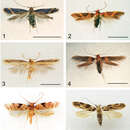Description
(
الإنجليزية
)
المقدمة من Zookeys
Male (n = 2; Fig. 3). Forewing length 5.0 mm.Head with pale brown scales radiating from compound eye. Haustellum with a mixture of light and dark brown scales. Maxillary palpus reduced. Labial palpus recurved and covered in pale brown scales, which are dark laterally. Antennal flagellum pale brown, with a ring of dark brown scales extending from the proximal margin of each flagellomere. Thorax mainly pale brown, dark brown at cervical margin and near posterior margin of notum. Foreleg dark brown with pale brown ring at distal margin of femur. Midleg as foreleg, but with pale brown ring at distal margin of tibia and tarsomeres I-V, spurs pale brown. Hindleg as midleg but longer with long pale brown hairs. Forewing pale brown, with dark brown band extending from costal margin of wing base to apex, mark forming a convex arch near apex. A separate brown band extends along anal margin of forewing. Fringe pale brown. Hindwing and hindwing fringe grayish brown. Abdomen dorsally dark brown; ventrally pale brown with a tuft of long pale brown scales on either side of genitalia.
Male genitalia. (Fig. 14). Right brachium of uncus sickle shaped, rather thick, heavily sclerotized, slender at apical 1/3, slightly twisted to left. Left brachium small, not sclerotized. Tegumen wide and sclerotized. Valvae asymmetrical, left valva slightly wider at middle than right, with three long sclerotized club-shaped setae along dorsal margin curving posteriorly. Dorsal margin of right valva smooth, lacking setal sockets. Phallus stout, blunt tipped, heavily sclerotized, and bent ventrad at about 1/2 of length; vesica without spines or cornuti. Anellus with two symmetrical rounded lobes, thin until apex, both adorned with few small setae.
Female. (n = 1). Externally as male, but with longer forewing length (5.8 mm) and small dark brown mark medially below dark band on forewing.
Female genitalia. (Fig. 19). Papillae anales long and setose. Anterior and posterior apophyses thin and straight, slightly enlarged at posterior end, posterior apophyses about 2x length as anterior apophyses. Ostium bursae small, heavily sclerotized, externally protruding into a triangle, not snail-shaped. Corpus bursae oval with light scobination; signum absent. Ductus bursae thick, approximately 1/2 length of corpus bursae. Apical margin of tergum VIII with median emargination.
Larval case. (n = 5; Fig 7). The mature case is 5.9–6.6 mm in length and 1.2–1.5 mm wide, smooth with banding that follows the length of the case. The case widens slightly at both ends.
- ترخيص
- cc-by-3.0
- حقوق النشر
- Akito Y. Kawahara, Daniel Rubinoff
- الاقتباس الببليوغرافي
- Kawahara A, Rubinoff D (2012) Three new species of Fancy Case caterpillars from threatened forests of Hawaii (Lepidoptera, Cosmopterigidae, Hyposmocoma) ZooKeys 170: 1–20
- مؤلف
- Akito Y. Kawahara
- مؤلف
- Daniel Rubinoff
Distribution
(
الإنجليزية
)
المقدمة من Zookeys
Known only from Volcano Village, Hawaii Island. Probably restricted to the rainforest areas around Hawaii Volcanoes National Park, where it appears to be uncommon. The elevation for the type locality is approximately 1200 m.
- ترخيص
- cc-by-3.0
- حقوق النشر
- Akito Y. Kawahara, Daniel Rubinoff
- الاقتباس الببليوغرافي
- Kawahara A, Rubinoff D (2012) Three new species of Fancy Case caterpillars from threatened forests of Hawaii (Lepidoptera, Cosmopterigidae, Hyposmocoma) ZooKeys 170: 1–20
- مؤلف
- Akito Y. Kawahara
- مؤلف
- Daniel Rubinoff

